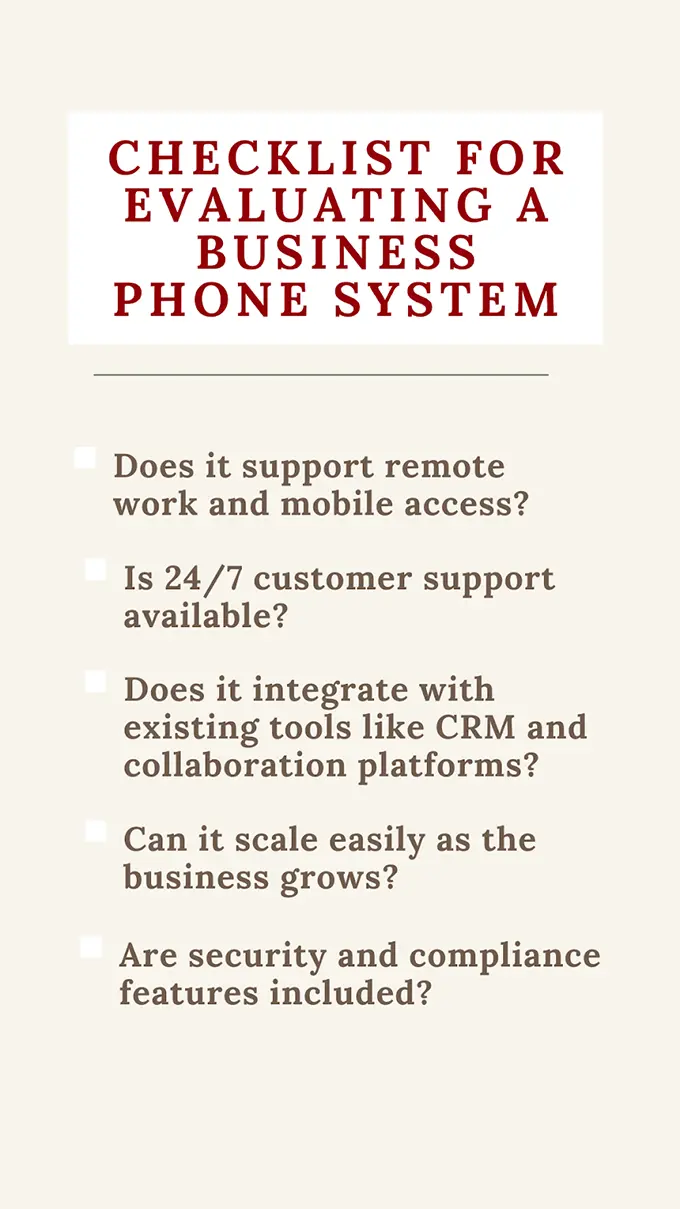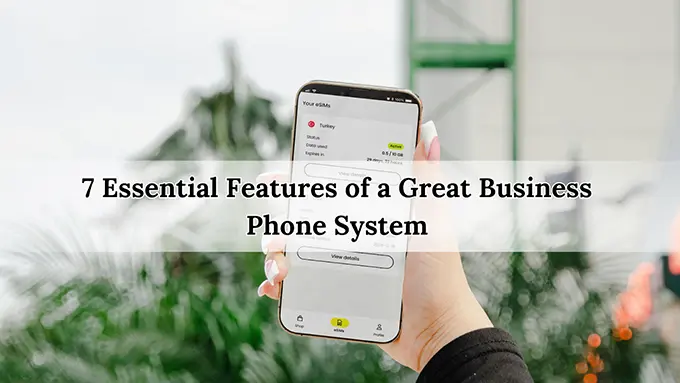Are you struggling with call quality issues, high maintenance costs, or managing remote teams effectively? The right business phone system can do more than just handle calls—it can transform the way your business operates.
With options like VoIP integration and mobile compatibility, modern phone systems are designed to improve efficiency, collaboration, and security.
But how do you pick the right one? Let’s explore the essential features you need and uncover how they address the day-to-day concerns of business owners like you.
What Is a Business Phone System?
A business phone system is essential because it ensures seamless communication. It is the backbone of any organization’s operations as it centralizes communication channels. It allows teams to connect internally and respond to customers quickly, thereby improving efficiency and customer satisfaction.
Integrating eSIM technology into a business phone system enhances flexibility, mobility, and cost-efficiency. eSIMs enable seamless connectivity for remote teams and international travelers by allowing instant network switching without physical SIM cards, reducing roaming costs.
Each year, countless business travelers head to France with 10 million of them leveraging esim solutions. With esim card france, business travelers can enjoy seamless connectivity without the hassle of using any physical SIM cards.
With this facility, businesses can manage devices remotely, quickly adding or reassigning numbers, which accelerates onboarding and streamlines operations.
Features of Business Phone System
1. Cloud-Based Infrastructure
A cloud-based phone system allows businesses to manage calls over the Internet rather than relying on traditional phone lines.
- Scalability: Easily add or remove users as the business grows or changes.
- Lower Costs: No need for expensive hardware and minimal maintenance costs.
- Remote Access: Employees can work from anywhere with an internet connection.
| Traditional Phone Systems | Cloud-Based Phone Systems |
| Requires on-site hardware | Hosted in the cloud |
| Higher setup and maintenance costs | Lower setup and operational costs |
| Limited flexibility | Easily scalable and adaptable |
2. VoIP Integration
Voice over Internet Protocol (VoIP) allows businesses to make calls using internet connections, providing crystal-clear audio and cost-effective communication.
- Cost Savings: Reduces international and long-distance call expenses.
- High Call Quality: VoIP improves audio clarity with stable internet.
- Unified Communication: Easily integrates with other tools like CRM and messaging apps.
Pro Tip: Ensure your internet connection is fast and reliable to avoid disruptions in VoIP call quality.
3. Auto-Attendant and IVR (Interactive Voice Response)
An auto-attendant greets callers and directs them to the right department or individual. IVR enhances this by allowing callers to interact using voice commands or touch-tone responses.
- Professional Call Handling: Automated greetings create a polished brand image.
- Efficient Call Routing: Routes calls to the appropriate person or department instantly.
- Self-Service Options: IVR systems reduce the need for human operators by providing common information, such as store hours, guide international travelers, and offer payment instructions.
4. Call Management and Analytics
Call management tools help businesses monitor, route, and log calls effectively. Analytics provide insights into call durations, wait times, and customer interactions.
- Call Queuing: Handles multiple calls simultaneously without dropping connections.
- Call Forwarding: Redirects calls to another number or voicemail when unavailable.
- Detailed Call Reports: Track key metrics like missed calls, call duration, and call volumes.
| Metric | Purpose |
| Call Volume | Helps plan staffing and peak hours |
| Average Call Duration | Monitors agent productivity |
| Abandonment Rate | Identifies potential bottlenecks |
5. Unified Communications and Collaboration Tools
Modern businesses rely on seamless collaboration tools that integrate with phone systems. Unified communications combine calling, messaging, video conferencing, and file sharing into a single platform.
- Streamlined Workflows: One platform for all communication needs.
- Improved Team Collaboration: Enable easy file sharing and group messaging.
- Video Conferencing Integration: Join meetings instantly without switching apps.
Example Use Case: Sales teams can make calls, share files, and join meetings from a single interface, reducing downtime between tasks.
6. Mobile App Compatibility
A great business phone system offers mobile app support, enabling employees to manage calls and messages.
- Flexibility: Employees can answer calls even when they are away from the office.
- Seamless Integration: Syncs with the desktop version, ensuring continuity across devices.
- Mobile Features: Access to voicemail, call logs, and contacts via smartphone apps.
7. Security and Compliance Features
Security is critical when dealing with business communications. A robust phone system should protect data and ensure compliance with industry regulations such as GDPR or HIPAA.
- Encryption: Protects calls and messages from unauthorized access.
- Two-Factor Authentication: Ensures secure login for employees.
- Call Recording Compliance: Enables compliant call recording for industries with strict regulations.
| Feature | Function |
| Encryption | Safeguards communication data |
| Two-Factor Authentication | Prevents unauthorized access |
| Compliance Monitoring Tools | Ensures adherence to industry standards |
Common Challenges and Solutions
Even advanced phone systems encounter challenges. Below are key issues and actionable solutions to keep your communication seamless.
1. Call Quality Issues with VoIP
Challenge: Poor audio due to latency, jitter, or dropped calls.
Solution: Use QoS (Quality of Service) settings to prioritize voice traffic. Upgrade network hardware and monitor bandwidth to avoid congestion.
2. Data Privacy Risks in Remote Work
Challenge: Remote work increases the risk of data breaches and compliance issues (e.g., GDPR, HIPAA).
Solution: Implement end-to-end encryption and VPNs for remote workers. Use MFA (Multi-Factor Authentication) to secure system access.
3. Dropped Calls During Peak Hours
Challenge: High call volumes result in missed or dropped calls.
Solution: Use call queuing and overflow routing to manage traffic. Monitor analytics to adjust staffing during peak hours.
4. Lack of Integration with Tools
Challenge: Disconnected systems hinder efficiency.
Solution: Opt for phone systems with API integrations for CRMs and unified communication platforms. Automate call logging and streamline workflows.
5. Onboarding and Adoption Challenges
Challenge: Employees struggle to adapt to new systems.
Solution: Provide comprehensive training and create easy-to-follow tutorials. Use system champions within departments to assist with adoption.
6. Security Threats from VoIP Systems
Challenge: VoIP systems are vulnerable to cyberattacks.
Solution: Use firewalls, SBCs (Session Border Controllers), and MFA to secure communications. Conduct regular audits to detect vulnerabilities.
Traditional vs. Cloud-Based Phone Systems
| Feature | Traditional Phone Systems | Cloud-Based Phone Systems |
| Hardware Requirement | On-site hardware needed | Hosted in the cloud |
| Setup and Maintenance Costs | High | Low |
| Scalability | Limited | Easily scalable |
| Remote Access | No | Yes |
| Integration | Minimal | Seamless with CRM, messaging tools |
Checklist for Evaluating a Business Phone System

Future Trends in Business Phone Systems
Business phone systems are evolving rapidly. Stay ahead of the curve by understanding these emerging trends:
- AI-Powered Call Assistants: Automate routine tasks, such as answering FAQs or routing calls, saving time and reducing human errors.
- 5G Integration: Boost mobile call quality, minimize latency, and improve communication reliability, even in remote areas.
- Voice Analytics: Track customer sentiment and analyze interactions in real-time, helping businesses enhance customer service strategies.
Final Thoughts
Choosing the right phone system can make or break your business’s ability to communicate effectively. Modern systems with cloud-based infrastructure, VoIP integration, and mobile apps provide flexibility and scalability that traditional systems just can’t match. Now the question is—are you ready to switch to a smarter business phone system that meets your needs today and grows with you tomorrow?
Frequently Asked Questions
- What makes VoIP better than traditional phone lines?
VoIP offers better call quality, lower costs for international calls, and integrates with other business tools. - Can mobile app compatibility improve productivity?
Yes, mobile apps let employees manage calls and messages from anywhere, keeping operations smooth even outside the office. - What’s the advantage of using IVR in a business phone system?
IVR automates call routing, reducing wait times and creating a more professional caller experience. - How do modern phone systems ensure data security?
Features like encryption, two-factor authentication, and compliance tools protect your data and keep you aligned with industry regulations.
